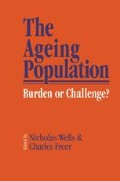Abstract
It is ironic that one of the unintended consequences of attempts to improve the circumstances and status of the elderly has been the tendency to describe them in an undifferentiated fashion. Ironic — but understandable: because the more those over a certain age are described as a group with shared experiences and deprivations, the more they are likely to obtain material improvements. While there can be no doubt that by comparison with younger age groups the elderly share a number of deprivations, this must not blind us to substantial differences between the elderly themselves. This chapter is concerned with the internal social differentiation of the distribution of personal resources — social, material, and mental and physical health — between age cohorts, sex groups and social classes. This is followed by a more focused examination of the distribution of these resources between a number of commonly identified risk groups — for example, those who live alone, the childless, recent movers. It ends with a more speculative examination of differentiation through the identification of lifestyle clusters.
Access this chapter
Tax calculation will be finalised at checkout
Purchases are for personal use only
Preview
Unable to display preview. Download preview PDF.
References
Abrams, M. (1978, 1980). Beyond Three Score Years and Ten (First and Second Reports on a Survey of the Elderly). Age Concern England, Mitcham
Atchley, R. C. (1976). Selected social and psychological differences between men and women in later life. J. Gerontol., 31 (2), 204
Ford, G. and Taylor, R. C. (1984). Differential ageing: an exploratory approach using cluster analysis. Int. J. Ageing Hum. Dev., 18 (2), 141
Registrar General (Scotland) (1982). Annual Reports. Edinburgh
Shanas, E., Townsend, P., Wedderburn, D., Friis, H., Stenhouwer, J. and Milhø, J. P. (1968). Old People in Three Industrial Societies. Routledge and Kegan Paul, London
Shanas, E., Townsend, P., Wedderburn, D., Friis, H., Stenhouwer, J. and Milhø, J. P. (1979). Old People in Three Industrial Societies. Routledge and Kegan Paul, London, later edition
Taylor, R. C. and Ford, G. (1983a). The elderly at risk: a critical examination of commonly identified risk groups. J. Roy. Coll. Gen. Pract., 33 (256), 699
Taylor, R. C. and Ford, G. (1983b). Inequalities in old age: an examination of age, sex and class differences in a sample of community elderly. Ageing and Society, 3 (2), 183
Townsend, P. (1979). Poverty in the United Kingdom. Penguin, London
Editor information
Editors and Affiliations
Copyright information
© 1988 The Editors and the Contributors
About this chapter
Cite this chapter
Taylor, R. (1988). The Elderly as Members of Society: An Examination of Social Differences in an Elderly Population. In: Wells, N., Freer, C. (eds) The Ageing Population. Palgrave, London. https://doi.org/10.1007/978-1-349-19093-5_7
Download citation
DOI: https://doi.org/10.1007/978-1-349-19093-5_7
Publisher Name: Palgrave, London
Print ISBN: 978-0-333-45313-1
Online ISBN: 978-1-349-19093-5
eBook Packages: Palgrave Social & Cultural Studies CollectionSocial Sciences (R0)

